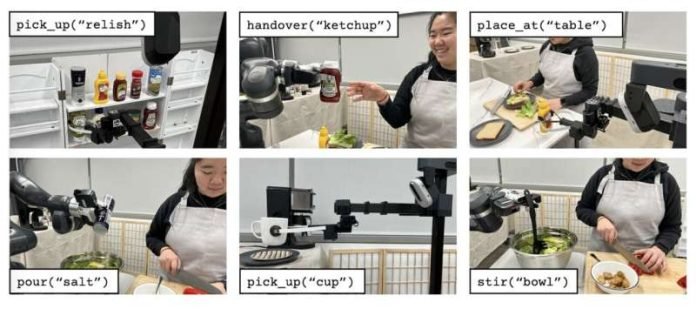
Researchers at Cornell University have made a significant leap forward in the world of home robotics with the development of MOSAIC, a sophisticated system designed to assist humans in performing complex household tasks, particularly interactive cooking.
This innovative approach, detailed in a study available on the arXiv preprint server, showcases the potential for robots to work alongside humans in more intimate and intricate activities than ever before.
MOSAIC stands out for its modular architecture, meaning it’s built from different parts that handle specific aspects of a task. This setup includes a component for planning tasks interactively, another for recognizing objects and planning robot movements, and a model for predicting human actions.
This design enables the system to utilize large-scale pre-trained models for general capabilities like understanding language and recognizing images, alongside more focused modules for direct task management.
In testing, MOSAIC was put through its paces in 60 real-world cooking trials alongside human participants.
These tests involved preparing six different recipes, ranging from salads and soups to a tuna sandwich, with the help of two robotic systems: the mobile Stretch Robot RE1 and the tabletop manipulator Franka Emilka Research 3.
The system managed to complete an impressive 68.3% of these trials successfully, demonstrating a high subtask completion rate of 91.6%.
The successful execution of these tasks marks a significant step toward integrating robots into everyday life, particularly in assisting with domestic chores like cooking.
While MOSAIC performed admirably in these initial trials, focusing mainly on simpler tasks such as moving objects, its application to more complex cooking techniques—like cutting or spreading—remains a challenge for future research.
The experiments conducted with MOSAIC were limited to a single kitchen environment, highlighting an area for further exploration: testing the system’s adaptability across different settings. Expanding the system’s capabilities and versatility will be crucial for its application in diverse household environments.
The development of MOSAIC not only brings us closer to the future of home robotics where machines assist with a variety of chores but also opens up new avenues for research in collaborative robotics.
As technology continues to evolve, we may soon see robots becoming an integral part of our daily lives, helping to prepare meals, clean, and even offer companionship. The ongoing improvements to systems like MOSAIC will undoubtedly play a pivotal role in this transformative journey.
The research findings can be found in arXiv.
Copyright © 2024 Knowridge Science Report. All rights reserved.



